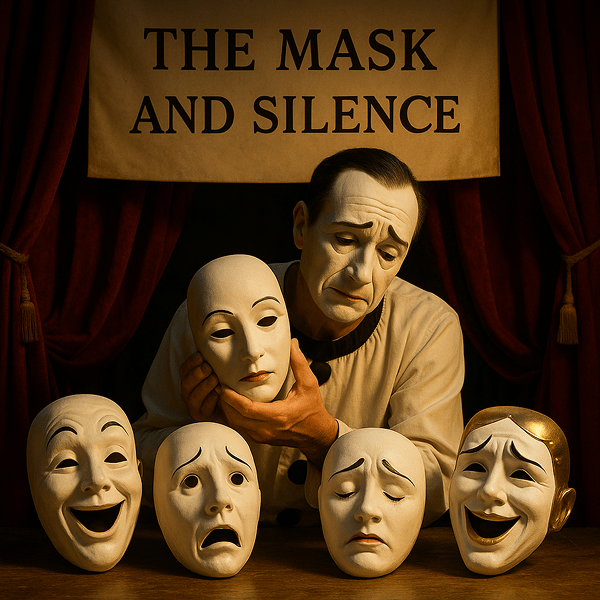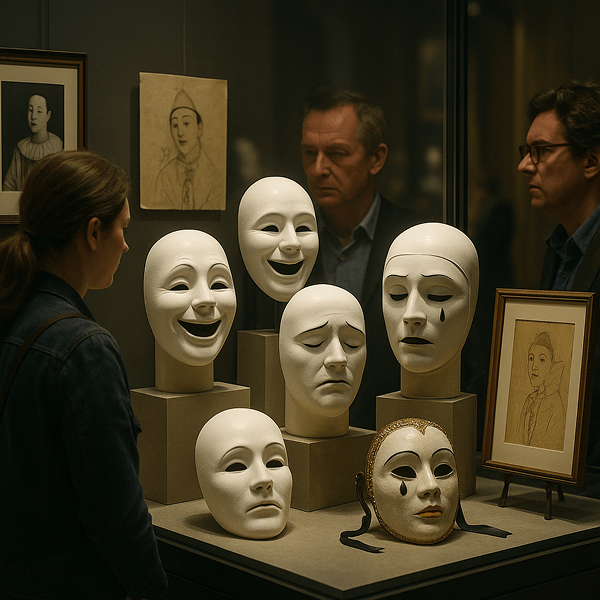Theatrical Pantomime Masks are a fundamental element of mime and silent performance traditions, instantly recognizable for their exaggerated, often white-painted features that express a wide range of emotions. Crafted to amplify facial expression and body language, these masks are usually smooth and minimalist, highlighting the eyes and mouth, sometimes with dramatic eyebrows or accent lines. The classic pantomime mask is associated with European theatre, especially the French tradition of pantomime and commedia dell’arte, but their influence is global — appearing in festivals, street performances, and modern experimental theatre. These masks are designed to be both neutral and extraordinarily expressive, serving as a blank canvas for the performer’s art.
Historical Origins of Pantomime Masks
The history of pantomime masks can be traced to the roots of Western theatre itself. The term “pantomime” comes from the Greek “pantomimos,” meaning “imitator of all,” and refers to a performer who expresses meaning through gesture without speech. The mask’s function in pantomime derives from ancient Greek and Roman theatre, where actors wore masks to play multiple roles and project emotion to large audiences. During the Italian Renaissance, commedia dell’arte popularized half-masks and character faces for archetypes such as Arlecchino and Pierrot, the latter becoming an iconic figure in French pantomime. By the 18th and 19th centuries, the white face of the mime — epitomized by Jean-Gaspard Deburau’s Pierrot — became the standard. Over centuries, the design of pantomime masks evolved alongside theatre technology and artistic fashion, shifting from ornate papier-mâché to lightweight, modern materials. Notable artifacts include early commedia masks, photographs of 19th-century French mimes, and creative reinterpretations by 20th-century artists. The expressive possibilities of pantomime and mask performance have also been influenced by Puppet Theatre Masks, with their own unique visual language.
Cultural Significance and Symbolism of Pantomime Masks
Pantomime masks hold powerful symbolic value in their home cultures. In Europe, the white mask or painted face is associated with innocence, vulnerability, and the universality of human emotion. The mask serves as both a shield and a revelation — concealing the individual while revealing archetypal states of joy, sorrow, surprise, or fear. Myths and legends about famous pantomime artists, such as Pierrot’s tragic love, reinforce the mask’s connection to melancholy and poetic introspection. In performance, the mask’s neutrality allows audiences to project their own feelings onto the character, making pantomime a deeply interactive art form. Socially, pantomime masks have been used to critique authority, lampoon social norms, and cross cultural or linguistic boundaries. In some traditions, the mask takes on spiritual or ritual significance, representing the crossing between worlds of silence and speech, reality and fantasy.

Materials and Craft Techniques of Pantomime Masks
Traditional pantomime masks are crafted from lightweight materials such as papier-mâché, plaster, resin, or modern plastics. Artisans create smooth, neutral surfaces, often painted in bright white, with minimal but expressive features — arched eyebrows, outlined lips, and exaggerated eyes. The process typically involves sculpting a clay or plaster model, creating a mold, and casting the final mask. Fine brushes are used for painting, with some masks adding touches of red, black, or blue for emphasis. In some schools, masks are made to custom-fit the performer’s face, allowing for maximum comfort and movement. Regional differences exist: Italian commedia masks may use leather and vibrant colors, while French pantomime favors minimalism. Color symbolism is subtle but important — white for purity and emptiness, black for mystery or tragedy, red for passion or comedy. Decorative elements are rare, as the mask’s power lies in its simplicity and the performer’s skill.
Functions and Uses of Pantomime Masks
Theatrical Pantomime Masks serve multiple functions in both traditional and contemporary performance. On stage, they are used by mimes and actors to create silent narratives, relying on gesture, movement, and facial expression to communicate meaning. Masks allow performers to play multiple roles, transcend gender or age, and amplify emotional states. In festivals, parades, and street theatre, pantomime masks are used to engage audiences, provoke laughter, or evoke empathy. In some cultures, masks are incorporated into rituals or celebrations marking transitions such as Carnival or All Souls’ Day. Over time, the use of pantomime masks has adapted to modern theatre, film, and television, where they appear in experimental drama, dance, and even popular music videos. Their continued presence underscores their versatility and enduring appeal.
Regional Variations of Pantomime Masks
While the classic pantomime mask is most closely associated with French and Italian theatre, regional variations abound. In Italy, commedia dell’arte developed a wide range of half-masks for stock characters, each with its own history and symbolism. In France, the Pierrot mask evolved into a symbol of poetic melancholy and artistic innovation. In Eastern Europe, pantomime traditions incorporated folk motifs and vibrant colors. In Latin America, Carnival and festival performances feature masks that blend pantomime elements with indigenous and colonial influences. Comparisons with Asian mask theatre show both shared techniques (such as neutral faces and silent performance) and distinct cultural aesthetics. Each region adapts pantomime mask design to local stories, social issues, and artistic tastes.
Famous Examples and Collections of Pantomime Masks
Famous pantomime masks can be found in theatre museums, costume collections, and private archives across Europe and beyond. The Comédie-Française (Paris), the Museo Internazionale della Maschera (Italy), and the Victoria and Albert Museum (London) hold historic examples of commedia and pantomime masks. Notable collections include 19th-century Pierrot masks, masks used by Marcel Marceau, and creative masks from avant-garde theatre troupes. Photographic archives, costume sketches, and video recordings document the evolution of pantomime mask design. Online resources and digital galleries, such as toddmasks.com, provide virtual access to rare and contemporary examples for researchers, performers, and enthusiasts worldwide.

Influence of Pantomime Masks on Art and Culture
Pantomime Masks have left a deep imprint on visual art, literature, and popular culture. Their iconic white face and expressive features have inspired painters, sculptors, and filmmakers — from Picasso and Chagall to Charlie Chaplin and Marcel Marceau. In literature and cinema, the pantomime mask often symbolizes innocence, alienation, or the paradox of silence and expression. Modern fashion designers and graphic artists use pantomime mask motifs in costume design, advertising, and stage sets. The preservation and adaptation of pantomime mask traditions play a key role in cultural education and creative innovation, keeping the art form relevant for new audiences and generations.
Contemporary Status and Preservation of Pantomime Mask Traditions
Today, pantomime masks are celebrated in theatres, festivals, and educational programs around the world. Master mask-makers, theatre companies, and mime schools continue to refine traditional techniques, while contemporary artists experiment with new materials, digital media, and interdisciplinary performance. Museums, universities, and online platforms like toddmasks.com offer workshops, lectures, and virtual exhibitions to foster appreciation and skill development. Modern directors and choreographers often incorporate pantomime masks into dance, drama, and physical theatre, ensuring the ongoing vitality of the tradition. Preservation efforts also emphasize ethical collecting, documentation, and passing on the knowledge of mask-making and performance to future generations.
Collecting and Acquiring Pantomime Masks
The market for pantomime masks includes historic pieces, high-quality replicas, and contemporary designs. Masks can be acquired from master artisans, theatre costume shops, museums, and reputable online platforms. Prices range from affordable student models to valuable artist-signed masks. Collectors are advised to consider provenance, craftsmanship, material, and fit. Toddmasks.com provides expert guidance on collecting, authentication, and understanding the context and value of theatrical masks. Ethical collecting ensures respect for the cultural significance and artistic heritage of pantomime masks.
